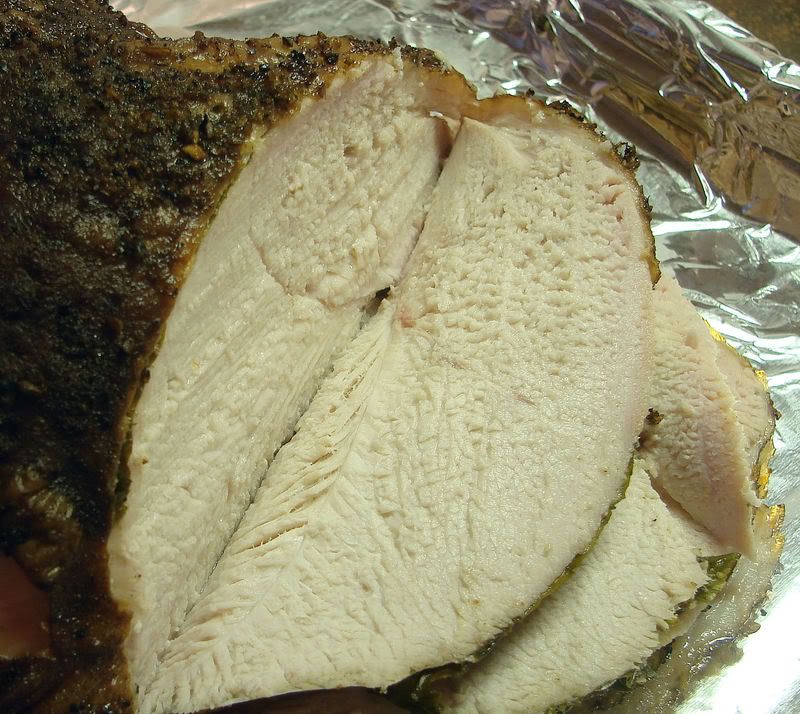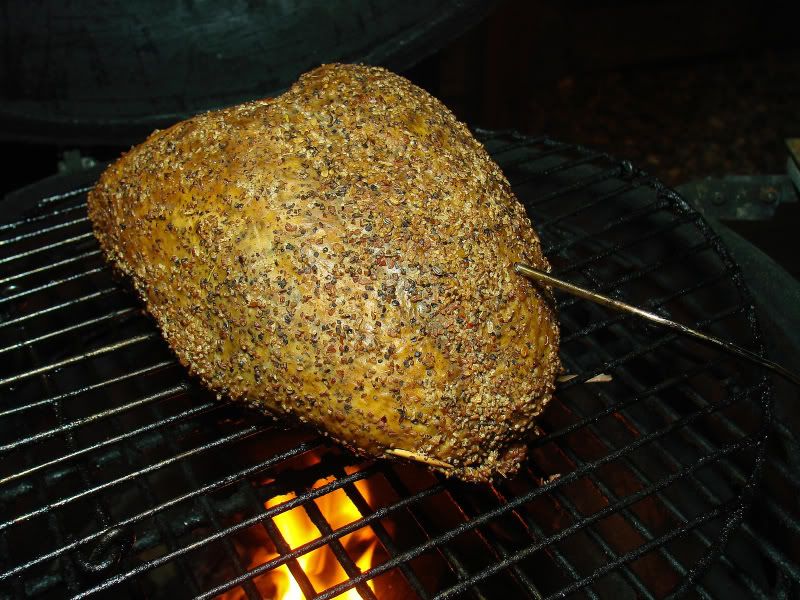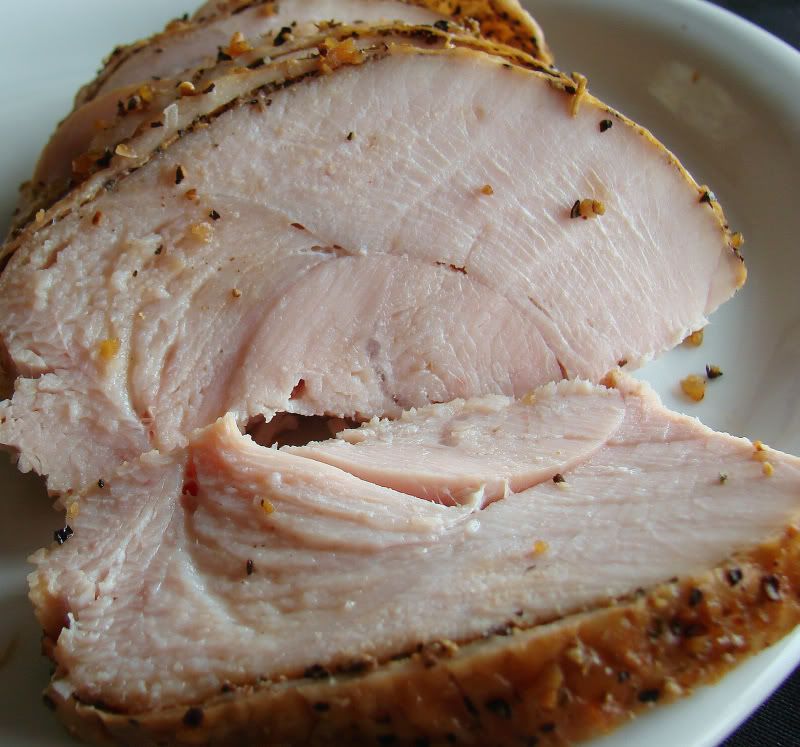Pastramied Turkey Breast - With Help From Old Dave

Because of their size and ease of cooking, Turkey breasts have always been a favorite at my house. I usually brine them, then either smoke them (using a lower pit temp) or roast them (using higher pit temps). Several years ago I decided to play with a pastrami technique and seasonings on my turkey breasts. The first step was to modify my standard poultry brine accordingly with more pepper, coriander and garlic. I also began to season the breast under the skin as well as another sprinkle of seasoning on the outside surface of the skin. This helped deliver more flavor to the breast, but because a turkey breast is a thick piece of meat, the flavor did not reach all the way inside. I increased the strength of the brine, adjusted the amount of Tenderquick, and also played with longer brine times, hoping to develop this technique. I was never really satisfied.
As I often do once I get the framework for an idea, I started posting about the turkey pastrami on several of the barbecue forums I frequent, admitting I was sort of stuck in the mud on this one. Among the many responses and suggestions I received was a short two line message from Dave Stamper along with his favorite brine recipe, which by the way is a variation of Shakes Honey Brine. This brine contained honey, cloves and pickling spice which were ingredients that I had not tried.... Okay, I liked the sound of this... but when I read the instructions one word jumped right off the page INJECT. That was what I was missing, and now my idea just got some much needed traction. And Dave was on his way to becoming a Guest Pit Boss. The first (and most important) step when using a benchmark recipe or technique to improve one that you are working with, is to try it without any changes. When I tried Dave's injection it was wonderful, the bird was moist and flavorful.
Dave has posted for a number of years as "Old Dave", and more recently as "Dipstick" on many barbecue forums and maintains an excellent blog called Old Dave's Po Farm. He is a real ambassador to barbecue, not only by mastering several different cookers, developing numerous cooking techniques & recipes, but he has been a mentor to myself and many, many others over the years. If you have ever smoked cheese, made pulled beef, barbecued on multi-levels or baked anything in a cooker, chances are you have benefited from some of Dave's knowledge. Here is the recipe I received from Guest Pit Boss, Old Dave.
~~~~~~~~~~~~~~~~~~~~
I like a brine based off of "Shakes" Injectable Brine. This is the recipe that I use most often for all of my poultry.
32oz clean water (non-chlorinated and not softened)
1/4 cup pickling salt
2 teaspoons of TenderQuick
1/3 cup clover honey
3-4 bay leaves
1/4 teaspoon ground cloves
1/2 teaspoon pickle spice
Heat it up in a sauce pan but do not boil. For a 12-15 pound turkey, inject 2 oz in each leg, 2 oz in each thigh, and 4 oz in each side of the breast. 16 oz total per turkey. I like to do the injection at least 8-10 hours before the fire.
Dave
To add another layer of flavor to his injectable brine Dave uses an Italian marinade and a special rub. The full details on his procedure can be found HERE
~~~~~~~~~~~~~~~~~~~~
Now, back to my pastramied turkey breast. Remember, pastrami refers to a piece of meat that has been cured, generously seasoned with a pepper based rub, then smoked. It can be served warm as a main meat or can be served cold on an appetizer tray or on a sandwich.

This process will take aroud 40 hours so here is a sample timetable for a Saturday cook, broken down into six easy steps. This should help you when planning your cook. More details on each step are below.
Thursday Evening:
1. Build the Turkey Pastrami Rub (a two part rub)
2. Fold back the skin from the turkey breast. Coat the breast meat with turkey pastrami rub, replace skin and refrigerate for 16 to 24 hours.
3. Mix the injection and refrigerate it in a non-reactive container
Friday Evening:
4. Fold back the skin, inject the breast with the chilled pastrami brine, relpace skin and secure with tooth picks. Sprinkle seasonings on the outside of the skin
5. Refrigerate for 8 to 12 hours
Saturday Morning
6. Smoke the turkey breast.

Here is the complete process in detail:
The Rub
Pastramied Turkey Rub - This is a two part rub containing the standard pastrami rub I use for smoking corned beef + garlic pepper (store bought). I wish I could tell you why mixing two rubs together works so well for me, but I can't. Contrary to the name, most garlic pepper mixes contain salt also, maybe the salt helps in the delivery of the flavors.
Rub - Part 1 - Pastrami Rub
4 tablespoons freshly ground black pepper
1 teaspoon ground coriander
1 teaspoon granulated garlic powder
1 teaspoon onion powder
2 teaspoons Canadian/Montreal Steak seasoning
1/2 teaspoon thyme, dried
1 teaspoon paprika
Combine all ingredients and mix thoroughly. This makes more that is needed for one turkey breast. The remainder can be stored in a Mason jar or in the freezer.
Rub - Part 2 Bottled Garlic Pepper - Store Bought
The Injection
Using Dave's injection recipe as a foundation, the addition of white pepper and a reduction in the amount of honey put me on the mark. (After many experiments, I decided against adding any of the seasonings I was using in the external rub)
Injectable Pastrami Brine - This will make enough for 4 turkey breasts
32oz clean water (non-chlorinated and not softened)
1/4 cup pickling salt
2 teaspoons of TenderQuick
1-2 teaspoons white pepper
1/4 cup clover honey
3-4 bay leaves
1/4 teaspoon ground cloves
1/2 teaspoon pickle spice
Heat it up in a sauce pan but do not boil. Then cool down.
Procedure
Peel back the skin on the breast, Rub a 50:50 mixture of garlic pepper and pastrami rub on the flesh and fold the skin back on, secure with one or two toothpicks to avoid shrinking. Refrigerate for 16 to 24 hours. Mix the injection, let it cool, then transfer to a non-reactive container and place in the refrigerator.
The next day, unfold the skin, trying not to disturb the layer of rub, and inject 4 ounces of the chilled brine into each side of the breast if you have a large breast (>5lbs), and 3 ounces if you have a smaller (<5lb). Replace the skin, but stretch and secure the skin with toothpicks. The breast goes back into the
fridge for 8 to 12 hours.
When you are ready to smoke, you have options with regards to pit temps. I like to start out with a low temp, around 250° for at least an hour. After that I either stick with that pit temp or ramp it up higher for the rest of the cook. The upside to staying with the 250° pit temp is the breast will be smokier. The downside of smoking at lower pit temps is the skin... it will be chewy. A higher temp finish will allow the skin to crisp up a little. You can even spray on some oil or paint on a light coat of butter & oil to aid browning. If fact you could even bring the breast inside into a 400° oven for a few minutes to crisp up the skin too.
Now for the big question.... "thirdeye, how long will this take to smoke?" Well, the answer is not that simple. The weight of breasts is not a constant, and pit temps are not a constant. For an average breast, started at 250° and finished closer to 300°, I usually plan on 3 hours for the smoke. Keeping the pit temp at 250° will take more time, as will a big greast. Just trust your instant read thermometer and don't cook by time alone.
When it comes off the smoker it will smell really good. You will want to sneak a slice.... DONT!!. Give it at least 15 minutes of resting. Following a rest, the breast can be eaten as a main meat. I also enjoy chilling them overnight for sandwiches or to use on an appetizer tray.

